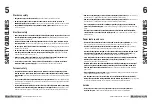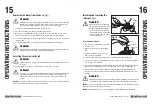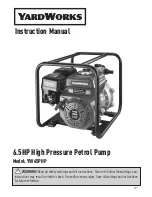
DIGITAL PLUNGE ROUTER - 054-6902-0
DIGITAL PLUNGE ROUTER - 054-6902-0
29
30
“Climb Cutting” may cause loss of control, possibly resulting in personal injury. When “Climb Cutting” is
required (backing around a corner, for example), exercise extreme caution to maintain control of the router.
The high speed of the cutter bit during a proper feeding operation (left to right), results in very little
kickback under normal conditions. However, if the cutter bit strikes a knot, an area of hard grain in the
wood workpiece or a foreign object, the normal cutting action could be affected and cause “Kickback”.
Kickback may damage to your workpiece and could cause you to lose control of the router, possibly
causing personal injury. Kickback is always in the opposite direction of the clockwise cutter bit rotation,
or counterclockwise.
To guard against and help prevent Kickback, plan your set-up and direction of feed so that you’re
always keeping the sharp edges of the cutter bit biting straight into new (uncut) wood (workpiece).
Also, always inspect your workpiece for knots, hard grain, and foreign objects that could cause a
kickback problem.
Direction of feed - internal cuts
(figs 14 and 14a)
When making an internal cut, such as a groove,
dado, or slot, always have the guide you are using
with the router (edge guide, straight edge, board
guide), on the right-hand side of the router as you
make the cut (fig 14).
When the guide is positioned on the right hand side of
the router, the router travel should be from left to right
and counterclockwise around curves (see fig 14).
This counterclockwise action around the curve could
cause “climb cutting”. Always be alert and exercise
extreme caution to maintain control of the router
when making this type of cut around curves.
When the guide is positioned as shown in fig 14a,
the router travel should be from right to left and
clockwise around curves.
If there is a choice, the set-up in fig 14 is easier to
use, but there is the possibility of “Climb Cutting”
around curves. In either case, fig 14 or fig 14a, the
sideways thrust of the router cutting is always against the guide, as is proper.
Rate of feed
(figs15a and 15b)
The proper rate of feed depends on several
factors: the hardness and moisture content of
the workpiece, the depth of cut, and the cutting
diameter of the bit. When cutting shallow grooves
in soft woods, such as pine, you may use a
faster rate of feed. When making deep cuts in
hardwoods, such as oak, you should use a slower
rate of feed.
Feeding too quickly
(fig 15a)
Clean and smooth cuts can only be achieved when
the cutter bit is rotating at a relatively high speed,
taking very small bites and producing tiny, clean-
cut chips.
Forcing the feed of the cutter bit forward too
quickly slows the rotational speed of the cutter bit
and the bit takes bigger bites as it rotates. Bigger
bites cause bigger chips and a rough finish. This
forcing action can also cause the router motor to
overheat.
Under extreme force-feeding conditions, the speed can become so slow and the bites become so large
that chips become partially cut off, causing splintering and gouging of the workpiece.
The router will make clean, smooth cuts if allowed to run freely without the overload of forced feeding.
You can detect forced feeding by the sound of the motor: its usual high-pitched whine will sound lower
and stronger as it loses speed. Holding the router against the workpiece will also be strained and
harder to do.
Feeding too slowly
(fig 15b)
When you feed the cutter bit too slowly, the rotating cutter bit does not cut into new wood rapidly
enough to take a bite. Instead, it scrapes away sawdust-like particles. This scraping produces heat,
which can glaze, burn, and mar the cut in the workpiece and, in extreme cases, overheat the cutter bit.
When the cutter bit is scraping instead of cutting, the router is more difficult to control as you feed it.
With almost no load on the motor, the cutter bit has a tendency to bounce off the sides
of the cut in the workpiece, producing a cut with a rippled finish instead of clean
straight sides.
OPERA
TING INSTR
UCTIONS
OPERA
TING INSTR
UCTIONS
fig 14
GUIDE OUTSIDE
BIT ROTATION
BIT ROTATION
ROTATION FEED DIRECTION
GUIDE
THRUST
fig 14a
GUIDE INSIDE
BIT ROTATION
BIT ROTATION
ROTATION FEED DIRECTION
GUIDE
THRUST
fig 15a
Bit Shank
Cut
Cutter
TOO FAST
fig 15b
Bit Shank
Cut
Cutter
TOO SLOW
Summary of Contents for 054-6902-0
Page 1: ...INSTRUCTION MANUAL DIGITAL PLUNGE ROUTER 054 6902 0...
Page 24: ......









































